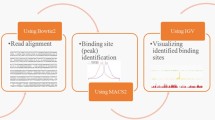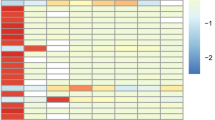Abstract
Breast cancer is a common malignancy in women and contribute largely to the cancer related death. The purpose of this study is to confirm the roles of GATA3 and identify potential biomarkers of breast cancer. Chromatin Immunoprecipitation combined with high-throughput sequencing (ChIP-Seq) (GSM1642515) and gene expression profiles (GSE24249) were downloaded from the Gene Expression Omnibus (GEO) database. Bowtie2 and MACS2 were used for the mapping and peak calling of the ChIP-Seq data respectively. ChIPseeker, a R bioconductor package was adopted for the annotation of the enriched peaks. For the gene expression profiles, we used affy and limma package to do normalization and differential expression analysis. The genes with fold change >2 and adjusted P-Value <0.05 were screened out. Besides, BETA (Binding and Expression Target Analysis) was used to do the combined analysis of ChIP-Seq and gene expression profiles. The Database for Annotation, Visualization and Integrated Discovery (DAVID) was used for the functional enrichment analysis of overlapping genes between the target genes and differential expression genes (DEGs). What’s more, the protein-protein interaction (PPI) network of the overlapping genes was obtained through the Human Protein Reference Database (HPRD). A total of 46,487 peaks were identified for GATA3 and out of which, 3256 ones were found to located at −3000 ~ 0 bp from the transcription start sites (TSS) of their nearby gene. A total of 236 down- and 343 up-regulated genes were screened out in GATA3 overexpression breast cancer samples compared with those in control. The combined analysis of ChIP-Seq and gene expression dataset showed GATA3 act as a repressor in breast cancer. Besides, 68 overlaps were obtained between the DEGs and genes included in peaks located at −3000 ~ 0 bp from TSS. Gene Ontology (GO) terms and Kyoto Encyclopedia of Genes and Genomes (KEGG) pathways related to cancer progression and gene regulation were found to be enriched in those overlaps. In the PPI network, NDRG1, JUP and etc. were found to directly interact with large number of genes, which might indicate their important roles in the progression of breast cancer.







Similar content being viewed by others
References
Gradishar WJ, Anderson BO, Balassanian R, Blair SL, Burstein HJ, Cyr A, Elias AD, Farrar WB, Forero A, Giordano SH, Goetz M, Goldstein LJ, Hudis CA, Isakoff SJ, Marcom PK, Mayer IA, McCormick B, Moran M, Patel SA, Pierce LJ, Reed EC, Salerno KE, Schwartzberg LS, Smith KL, Smith ML, Soliman H, Somlo G, Telli M, Ward JH, Shead DA, Kumar R (2016) Invasive breast cancer version 1.2016, NCCN clinical practice guidelines in oncology. Journal of the National Comprehensive Cancer Network. JNCCN 14(3):324–354
Pusztai L, Ladanyi A, Szekely B, Dank M (2016) Immunotherapy opportunities in breast cancer. Magyar onkologia 60(1):34–40
Liu D (2016) Tumor necrosis factor-alpha, a regulator and therapeutic agent on breast cancer. Curr Pharm Biotechnol 17(6):486–494
Maximiano S, Magalhaes P, Guerreiro MP, Morgado M (2016) Trastuzumab in the Treatment of Breast Cancer. BioDrugs: clinical immunotherapeutics, biopharmaceuticals and gene therapy doi:10.1007/s40259–016–0162-9
Kober KM, Dunn L, Mastick J, Cooper B, Langford D, Melisko M, Venook A, Chen LM, Wright F, Hammer M, Schmidt BL, Levine J, Miaskowski C, Aouizerat BE (2016) Gene Expression Profiling of Evening Fatigue in Women Undergoing Chemotherapy for Breast Cancer. Biological research for nursing doi:10.1177/1099800416629209
Cao ZG, Qin XB, Liu FF, Zhou LL (2015) Tryptophan-induced pathogenesis of breast cancer. Afr Health Sci 15(3):982–985. doi:10.4314/ahs.v15i3.36
Park E (2016) Data on cell cycle in breast cancer cell line, MDA-MB-231 with ferulic acid treatment. Data in brief 7:107–110. doi:10.1016/j.dib.2016.02.001
Asch-Kendrick R, Cimino-Mathews A (2016) The role of GATA3 in breast carcinomas: a review. Hum Pathol 48:37–47. doi:10.1016/j.humpath.2015.09.035
Si W, Huang W, Zheng Y, Yang Y, Liu X, Shan L, Zhou X, Wang Y, Su D, Gao J, Yan R, Han X, Li W, He L, Shi L, Xuan C, Liang J, Sun L, Wang Y, Shang Y (2015) Dysfunction of the Reciprocal Feedback Loop between GATA3- and ZEB2-Nucleated Repression Programs Contributes to Breast Cancer Metastasis. Cancer Cell 27(6):822–836. doi:10.1016/j.ccell.2015.04.011
McCleskey BC, Penedo TL, Zhang K, Hameed O, Siegal GP, Wei S (2015) GATA3 expression in advanced breast cancer: prognostic value and organ-specific relapse. Am J Clin Pathol 144(5):756–763. doi:10.1309/AJCP5MMR1FJVVTPK
Dieci MV, Smutna V, Scott V, Yin G, Xu R, Vielh P, Mathieu MC, Vicier C, Laporte M, Drusch F, Guarneri V, Conte P, Delaloge S, Lacroix L, Fromigue O, Andre F, Lefebvre C (2016) Whole exome sequencing of rare aggressive breast cancer histologies. Breast Cancer Res Treat 156(1):21–32. doi:10.1007/s10549–016-3718-y
Chu IM, Michalowski AM, Hoenerhoff M, Szauter KM, Luger D, Sato M, Flanders K, Oshima A, Csiszar K, Green JE (2012) GATA3 inhibits lysyl oxidase-mediated metastases of human basal triple-negative breast cancer cells. Oncogene 31(16):2017–2027. doi:10.1038/onc.2011.382
Gautier L, Cope L, Bolstad BM, Irizarry RA (2004) Affy--analysis of Affymetrix GeneChip data at the probe level. Bioinformatics 20(3):307–315. doi:10.1093/bioinformatics/btg405
Langmead B (2010) Aligning short sequencing reads with Bowtie. Current protocols in bioinformatics / editoral board, Andreas D Baxevanis [et al] Chapter 11:Unit 11 17. doi:10.1002/0471250953.bi1107s32
Feng J, Liu T, Qin B, Zhang Y, Liu XS (2012) Identifying ChIP-seq enrichment using MACS. Nat Protoc 7(9):1728–1740. doi:10.1038/nprot.2012.101
Yu G, Wang LG, He QY (2015) ChIPseeker: an R/bioconductor package for ChIP peak annotation, comparison and visualization. Bioinformatics 31(14):2382–2383. doi:10.1093/bioinformatics/btv145
Wang S, Sun H, Ma J, Zang C, Wang C, Wang J, Tang Q, Meyer CA, Zhang Y, Liu XS (2013) Target analysis by integration of transcriptome and ChIP-seq data with BETA. Nat Protoc 8(12):2502–2515. doi:10.1038/nprot.2013.150
Dennis G Jr, Sherman BT, Hosack DA, Yang J, Gao W, Lane HC, Lempicki RA (2003) DAVID: Database for Annotation, Visualization, and Integrated Discovery. Genome Biol 4(5):P3
Keshava Prasad TS, Goel R, Kandasamy K, Keerthikumar S, Kumar S, Mathivanan S, Telikicherla D, Raju R, Shafreen B, Venugopal A, Balakrishnan L, Marimuthu A, Banerjee S, Somanathan DS, Sebastian A, Rani S, Ray S, Harrys Kishore CJ, Kanth S, Ahmed M, Kashyap MK, Mohmood R, Ramachandra YL, Krishna V, Rahiman BA, Mohan S, Ranganathan P, Ramabadran S, Chaerkady R, Pandey A (2009) Human Protein Reference Database--2009 update. Nucleic Acids Res 37(Database issue):D767–D772. doi:10.1093/nar/gkn892
Shannon P, Markiel A, Ozier O, Baliga NS, Wang JT, Ramage D, Amin N, Schwikowski B, Ideker T (2003) Cytoscape: a software environment for integrated models of biomolecular interaction networks. Genome Res 13(11):2498–2504. doi:10.1101/gr.1239303
Lin Y, Zhao J, Hu X, Wang L, Liang L, Chen W (2016) Transcription factor CCAAT/enhancer binding protein alpha up-regulates microRNA let-7a-1 in lung cancer cells by direct binding. Cancer Cell Int 16:17. doi:10.1186/s12935–016–0294-5
Li C, Deng L, Zhi Q, Meng Q, Qian A, Sang H, Li X, Xia J (2016) MicroRNA-183 Functions As an Oncogene by Regulating PDCD4 in Gastric Cancer. Anti Cancer Agents Med Chem 16(4):447–455
Mitxelena J, Apraiz A, Vallejo-Rodriguez J, Malumbres M, Zubiaga AM (2016) E2F7 regulates transcription and maturation of multiple microRNAs to restrain cell proliferation. Nucleic Acids Res. doi:10.1093/nar/gkw146
Takaku M, Grimm SA, Wade PA (2015) GATA3 in Breast Cancer: Tumor Suppressor or Oncogene? Gene Expr 16(4):163–168. doi:10.3727/105221615X14399878166113
Tkocz D, Crawford NT, Buckley NE, Berry FB, Kennedy RD, Gorski JJ, Harkin DP, Mullan PB (2012) BRCA1 and GATA3 corepress FOXC1 to inhibit the pathogenesis of basal-like breast cancers. Oncogene 31(32):3667–3678. doi:10.1038/onc.2011.531
Xiong Y, Castro E, Yagi R, Zhu J, Lesourne R, Love PE, Feigenbaum L, Bosselut R (2013) Thpok-independent repression of Runx3 by Gata3 during CD4+ T-cell differentiation in the thymus. Eur J Immunol 43(4):918–928. doi:10.1002/eji.201242944
Liu W, Yue F, Zheng M, Merlot A, Bae DH, Huang M, Lane D, Jansson P, Lui GY, Richardson V, Sahni S, Kalinowski D, Kovacevic Z, Richardson DR (2015) The proto-oncogene c-Src and its downstream signaling pathways are inhibited by the metastasis suppressor, NDRG1. Oncotarget 6(11):8851–8874. doi:10.18632/oncotarget.3316
Salis O, Bedir A, Kilinc V, Alacam H, Gulten S, Okuyucu A (2014) The anticancer effects of desferrioxamine on human breast adenocarcinoma and hepatocellular carcinoma cells. Cancer biomarkers: section A of Disease markers 14(6):419–426. doi:10.3233/CBM-140422
Song JY, Lee JK, Lee NW, Jung HH, Kim SH, Lee KW (2008) Microarray analysis of normal cervix, carcinoma in situ, and invasive cervical cancer: identification of candidate genes in pathogenesis of invasion in cervical cancer. International journal of gynecological cancer: official journal of the international gynecological cancer. Society 18(5):1051–1059. doi:10.1111/j.1525-1438.2007.01164.x
Wang Y, Zheng T (2014) Screening of hub genes and pathways in colorectal cancer with microarray technology. Pathol Oncol Res: POR 20(3):611–618. doi:10.1007/s12253–013–9739-5
Acknowledgments
This work was supported by the Municipal Science and Technology Commission of Tianjin (No. 15ZLZLZF00440) and the Health Bureau Science and Technology Foundation of Tianjin (No. 2012KZ063 and No. 2014KZ102).
Author information
Authors and Affiliations
Corresponding author
Ethics declarations
Conflict of Interest
The authors declare that they have no conflict of interest.
Additional information
Pengfei Liu and Wenhua Jiang contributed equally to this study.
This work was supported by the Municipal Science and Technology Commission of Tianjin (No. 15ZLZLZF00440) and the Health Bureau Science and Technology Foundation of Tianjin (No. 2012KZ063 and No.2014KZ102).
Rights and permissions
About this article
Cite this article
Liu, P., Jiang, W., Zhou, S. et al. Combined Analysis of ChIP Sequencing and Gene Expression Dataset in Breast Cancer. Pathol. Oncol. Res. 23, 361–368 (2017). https://doi.org/10.1007/s12253-016-0116-z
Received:
Accepted:
Published:
Issue Date:
DOI: https://doi.org/10.1007/s12253-016-0116-z




